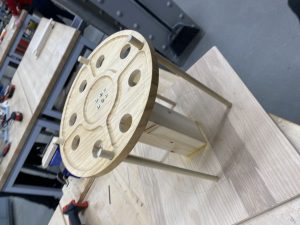This week our team completed some major milestones in our project. We got the robot fully assembled and got some movement out of it established from the computer. We also got the garnish wheel mechanism connected to the motor for it and assembled the parts for the solenoid valve pipes. We also completed the 11 page Design Review Document. For the garnish wheel selection and the solenoid valves, we have the circuit drawn out for it so all we have to do is receive all of the parts to actually test and assemble it.
There were no changes to the initial plan from this past week as we are still working through the assembly phase. As we plan ahead of the actually integration of the parts, we believe that it is best to each take on our own part and then integrate it afterwards. Howard will be working on the robotic arm, Arda will be working on the garnish wheel and Rohan will be working on the solenoid valves.
Given our progress on this week, we have set ourselves up to make the individual circuits, established by the Arduino. This will lead us to integrate the individual parts soon.
Currently, we believe we are on schedule. We had to make a slight deviation in our plans considering some of our parts didn’t arrive in time and. That being said we accomplished some later goals (such as the Facial Recognition) to even us out.
Free Response
Part A (Written by Arda):
The Bar Belt system addresses a global need for automated beverage precision. With the increasing demand for automation in home entertainment and hospitality, our project provides a scalable solution that minimizes labor costs and optimizes each drink’s efficiency. Since it is a cloud based infrastructure, this will allow for easy updates and remote operation, which makes it adaptable to various markets beyond Pittsburgh, including urban centers, homes and any hospitality venue.
This project can be generalized to anyone who has access to internet. Since the project will be entirely automated, the user won’t have to do anything except input the drink that they would like to drink. The WebApp interface will be intuitive and clear so that anyone will be able to use it, engaging users with any level of computer expertise. By being scalable, sustainable, and accessible, Bar Belt is made to serve for a global market.
Part B (Written by Howard):
Our project is designed to be able to adapt to different cultural and social drinking traditions. For instance, while some cultures may emphasize the base ingredients used, some others may be more focused on getting a good ratio. To accommodate to these different approaches, our system allows for customized drink recipes, ingredient selections, and precise volume mixing, ensuring users can recreate drinks consistently that suit whichever cultural custom they have.
Additionally, our system can be expanded to non-alcoholic beverages and ingredients, expanding the scope for the amount of drinks that could be created and reaching a wider range of users who may not want alcoholic contents. By integrating a flexible recipe database and ingredient selection process, users can enjoy a variety of mixed drinks with ingredients that they are able to pick themselves. Our approach ensures that the system is not only functional but also culturally adaptable, making it suitable for a diverse range of social settings.
Part C: (Written by Rohan)
Our project is designed with environmental sustainability in mind by minimizing waste, conserving resources, and promoting eco-friendly practices. By precisely controlling liquid dispensing through solenoid valves, the system reduces spills and ingredient waste, ensuring efficient use of beverages and garnishes. The automated mixing mechanism eliminates the need for disposable stirrers, reducing plastic waste.






